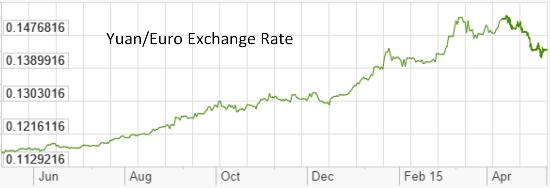When a country pegs its currency to a bigger one like the US dollar, it in effect outsources its monetary policy to the operator of that other currency. This confers several benefits, including the enforced discipline of the other, presumably more rigorous monetary regime and the simplicity of letting someone else stress over controversial policies like QE.
But of course there’s a downside to letting someone else handle important things, and in this case it’s that when the other country screws up its own monetary policy, the pegger becomes collateral damage. A case in point is China, which links its currency, the yuan, to the US dollar. As the next chart illustrates, the relationship was fairly stable in the past year.

But during that time the dollar has soared against other major currencies, which means so has the yuan. Here it is versus the euro:

Since Chinese exports are priced in yuan, they became around 20% more expensive in the past year. This, according to both basic economics and common sense, should result in Chinese companies selling less to foreigners and the Chinese economy slowing down. Let’s see how that worked out:
April 15, Reuters:
China growth slowest in six years, more stimulus expected soon
China grew at its slowest pace in six years at the start of 2015 and weakness in key sectors suggested the world’s second-largest economy was still losing momentum, intensifying Beijing’s struggle to find the right policy mix to shore up activity.Measures to support the property sector and a series of cuts in interest rates and bank reserve requirements look to have delivered less support to the economy than hoped, apart from feeding a stock market surge, raising expectations of more stimulus soon.
Gross domestic product (GDP) grew an annual 7.0 percent in the first quarter, slowing from 7.3 percent in the fourth quarter of 2014, China’s statistics bureau said. While matching the median forecast in a Reuters poll, some analysts said it seemed stronger than data on the components of growth suggested.
“Despite a headline growth rate in line with expectations, underlying economic activities appear to have softened further,” Qu Hongbin, HSBC’s co-head of Asian Economic Research, said in a note.
“We expect policy makers to deploy further monetary easing and other growth-supporting measures in the coming weeks.”
Analysts calculated the GDP deflator had fallen 1.2 percent, a six-year low, indicating broad deflationary pressures. Monthly retail sales, industrial output and fixed asset investment data released with the GDP figures all missed analyst expectations. Growth in fixed-asset investment (FAI), a key economic driver, was the slowest since 2000, while industrial output grew at its weakest since the global financial crisis in 2008. Power output, which some analysts use as a proxy for economic activity, fell an annual 3.7 percent in March, the biggest fall since the 2008 crisis. More bad news came from the real estate sector, a major economic pillar and where investment rose an annual 8.5 percent in the first quarter, the weakest rate since 2009.
May 7, CNBC:
China exports, imports fall sharply in April
China’s exports and imports tumbled in April, dashing hopes of a seasonal rebound and underscoring concerns over the soggy trade picture in the world’s second biggest economy. Exports fell 6.4 percent in April from the year-ago period, coming in worse than the 2.4 percent rise forecast in a Reuters poll and following a 15 percent plunge in March. Imports dived 16.2 percent on year, also missing the 12 percent expected drop and after falling 12.7 percent in March. This brought the trade surplus for the month to $34.13 billion, compared with the $39.45 billion forecast and March’s print of $30.8 billion.Weak external and domestic demand has been a key factor behind the slowing Chinese economy, which Beijing expects will grow around 7 percent this year. The economy expanded 7.4 percent in 2014, its slowest pace in 24 years and undershooting the government’s target for the first time since 1998.
The People’s Bank of China (PBOC) has responded with a series of monetary stimulus measures, most recently cutting the reserve requirement ratio (RRR) of major banks by 100 basis points to 18.5 percent in April, and analysts are expecting further moves.
May 10, BBC:
China cuts interest rates to 5.1% as economy slows
China’s central bank has cut interest rates for the second time this year, amid a continuing economic slowdown. It lowered its benchmark rate by 25 basis points to 5.1%, saying the move was aimed at boosting development.Last year’s growth rate – 7.4% down from 7.7% in 2013 – was the weakest in 24 years. The cut is the third in six months and will take effect from Monday. It follows other measures designed to spur growth in China, including tax cuts.
China’s slowdown is expected to continue for some years. Last week, the International Monetary Fund (IMF) predicted China’s growth would stabilise at about 6% by 2017. Also last week, weaker than expected official figures on both trade and inflation were released. The rate cut suggests data to be published this week, on industrial output and investment, may also disappoint. The country’s economic problems also include the property market, which is cooling after a damaging period that saw a speculative bubble emerge.
Heading lower
The central bank said in a statement: “China’s economy is still facing relatively big downward pressure.“At the same time, the overall level of domestic prices remains low, and real interest rates [interest rates relative to inflation] are still higher than the historical average.”
It’s a safe bet that by early 2016 both the US and China will be in aggressive easing mode, with another round of QE likely in the US. China, meanwhile, will come under increasing pressure to break the dollar peg and devalue the yuan.
In other words, the race to the bottom continues.
